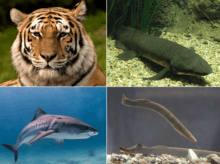Skeletochronology
Skeletochronology is a technique used to determine the individual, chronological ages of vertebrates by counting lines of arrested, annual growth, also known as LAGs, within Skeletal tissues[1]. Within the annual bone growth specimens, there are broad and narrow lines. Broad lines represent the growth period and narrow lines represent a growth pause[2]. These narrow lines are what characterises one growth year, therefore make it suitable to determine the age of the specimen[2]. Not all bones grow at the same rate and the individual growth rate of a bone changes over a lifetime[1], therefore periodic growth marks can take irregular patterns. This indicates significant chronological events in an individual’s life. The use of bone as a biomaterial is useful in investigating structure-property relationships[3]. In addition to current research in skeletochronology, the ability of bone to adapt and change its structure to the external environment provides potential for further research in bone histomorphometry in the future[4]. Amphibians and Reptiles are commonly aged determined, using this method, because they undergo discrete annual activity cycles such as winter dormancy or metamorphosis, however it cannot be used for all species of bony animals[5]. The different environmental and biological factorsthat influence bone growth and development can become a barrier in determining age as a complete record may be rare[6].
| Vertebrate | |
|---|---|
 | |
| Example of vertebrates: a Siberian tiger (Tetrapoda), an Australian Lungfish (Osteichthyes), a Tiger shark (Chondrichthyes) and a River lamprey (Agnatha). | |
| Scientific classification | |
| Kingdom: | Animalia |
| Phylum: | Chordata |
| Clade: | Olfactores |
| Subphylum: | Vertebrata J-B. Lamarck, 1801[9] |
| Simplified grouping (see text) | |
| |
| Synonyms | |
|
Ossea Batsch, 1788[9] | |
References
- K. Padian, A. H. Lee, H. Woodward Ballard (2013). "Skeletochronology". Bone Histology of Fossil Tetrapods: Advancing Methods, Analysis and Interpretation. 7: 195–215 – via JSTOR.
- L. Loebens, M.B. Dos Santos and S.Z Cechin, A.J.C Brum (2019). "First record of growth rings for 11 native subtropical anuran species in South America". An Acad Bras Cienc. 91: 1678–2690 – via SciELO.
- K.L. McNeill, M. Gonzalez-Howard, K. Close, M. Evans, J.B. Henderson (2017). "Key challenges and future directions for educational research on scientific argumentation". Journal of Research in Science Teaching. 55(1): 5–18.CS1 maint: multiple names: authors list (link)
- P. Fratzl, R. Weinkamer (2011). "Mechanical adaptation of biological materials – The examples of bone and wood". Principles and development of Bio-inspired materials. 31(6): 1164–1173.
- Hall, B.K (1993). "Bone Growth". CRC. 7: 253–269 – via JSTOR.
- Ehret, D.J (2007). "Skeletochronology: A method for determining the individual age and growth of modern and fossil tortoises (Reptilia: Testudines)". Florida Museum of Natural History. 47(2): 49–72.
- Shu; et al. (4 November 1999). "Lower Cambrian vertebrates from south China". Nature. 402 (6757): 42–46. Bibcode:1999Natur.402...42S. doi:10.1038/46965.
- Peterson, Kevin J.; Cotton, James A.; Gehling, James G.; Pisani, Davide (27 April 2008). "The Ediacaran emergence of bilaterians: congruence between the genetic and the geological fossil records". Philosophical Transactions of the Royal Society B: Biological Sciences. 363 (1496): 1435–1443. doi:10.1098/rstb.2007.2233. PMC 2614224. PMID 18192191.
- Nielsen, C. (July 2012). "The authorship of higher chordate taxa". Zoologica Scripta. 41 (4): 435–436. doi:10.1111/j.1463-6409.2012.00536.x.
- Zachos, J. C.; Kump, L. R. (2005). "Carbon cycle feedbacks and the initiation of Antarctic glaciation in the earliest Oligocene". Global and Planetary Change. 47 (1): 51–66. Bibcode:2005GPC....47...51Z. doi:10.1016/j.gloplacha.2005.01.001.
- M. Masafumi, E. Kyoko (2002). "Estimation of Age Structure by Skeletochronology of a Population of Hynobius nebulosus in a Breeding Season (Amphibia, Urodela)". Zoological Science. 19: 241–247.
- M. L. Snover, A. A. Hohn, G. H. Balazs, L. R. Goshe (2016). "Validation of back-calculated body lengths and timing of growth mark deposition in Hawaiian green sea turtles". Ecology and Evolution. 6(10): 3208–3215.CS1 maint: multiple names: authors list (link)
- X. Jordana, M. Kohler, C. Nacarine-Meneses (2016). "First approach to bone histology and skeletochronology of Equus hemionus". Comptes Rendus Palevol. 15(1): 267–277.
- U.C Erismis, F.M Guarino (2008). "Age determination and growth by skeletochronology by Rana holtzi, an endemic frog from Turkey". Italian Journal of Zoology. 75(3): 237–242.
- Blackburn, D. C.; Wake, D. B. (2011). "Class Amphibia Gray, 1825. In: Zhang, Z.-Q. (Ed.) Animal biodiversity: An outline of higher-level classification and survey of taxonomic richness" (PDF). Zootaxa. 3148: 39–55. doi:10.11646/zootaxa.3148.1.8.
- L. Brookes, T.W.J. Garner, S. Brod (2018). "Discussing the future of amphibians in research Report of the NC3Rs/ZSL Workshop on Amphibian Welfare". Lab Animal. 48: 16–18.
- Woodward, Aylin (2019). "Frogs are dying off at record rates – an ominous sign the 6th mass extinction is hitting one group of creatures hardest". Business Insider.
- D.H. Olson, S.K. McMenamin, K.A. Murray, M. Van Sluys, M.A. Donnelly, D. Stratford, J. Terhivuo, A. Merino-Viteri, S.M. Herbert, P.J. Bishop, P.S Corn, L. Dovey, R.A. Griffiths, K. Lowe, M. Mahony, H. McCallum, J.D. Shuker, C. Simpkins, L.F. Skerratt, S.E. Williams, J. Hero, L.P Shoo (2011). "Engineering a future for amphibians under climate change". Journal of Applied Ecology. 48(2): 487–492.CS1 maint: multiple names: authors list (link)